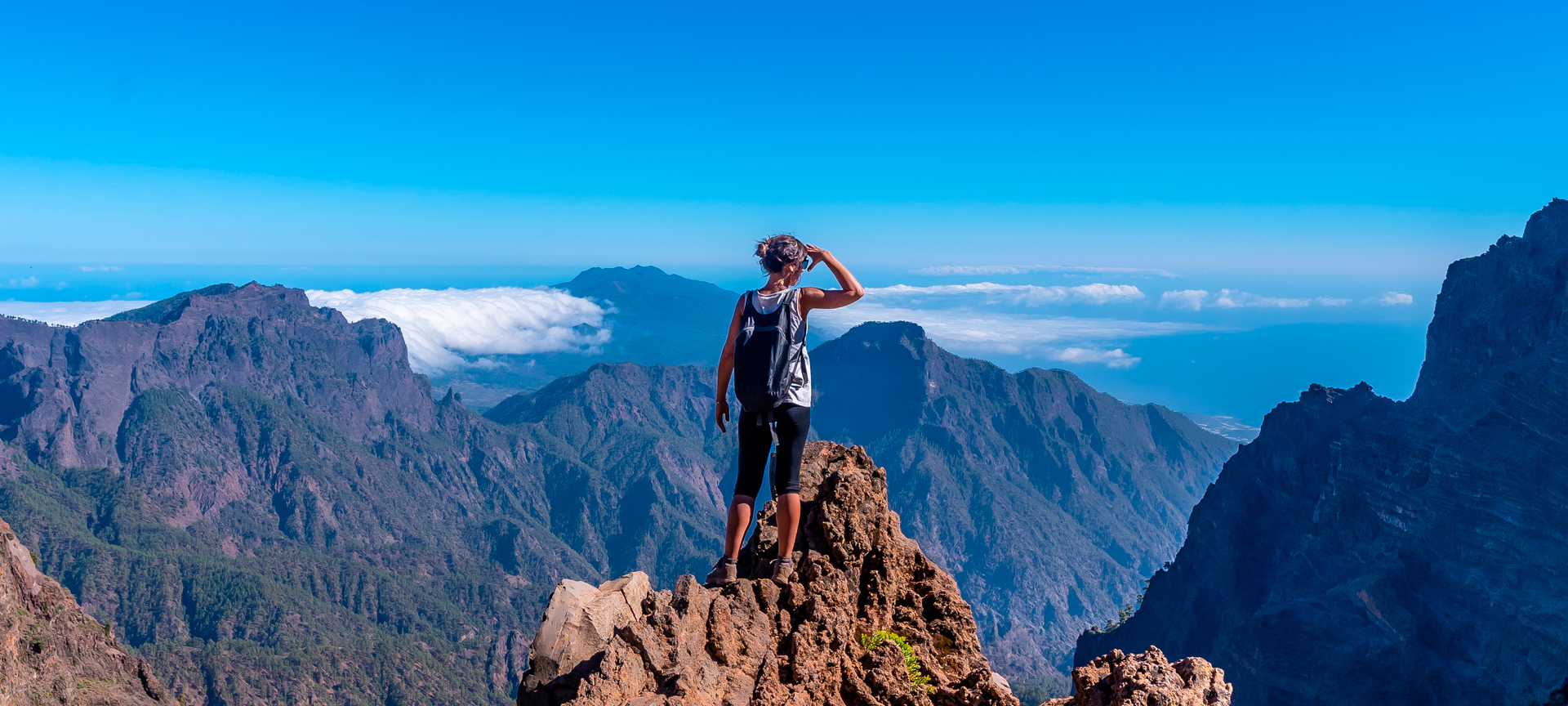
10 must-visit places on La Palma
Are you looking for a different holiday on an island, with good weather all year round and in direct contact with nature in the middle of the Atlantic Ocean? Come to La Palma, in the Canary Islands. Known as "La Isla Bonita", you will be surprised by the variety of its landscapes: from volcanoes to magical laurel forests, black sand beaches and natural pools. It has been declared a Biosphere Reserve and offers some of the most interesting trails in the Canary Islands. Ideally, book at least a week to explore it quietly in a rental car.The island is well connected by air: it has direct connections with several European countries like Germany, Holland, Belgium, England, Sweden, Denmark and Switzerland. Also, it has a direct connection with some continental-Spain cities like Madrid, Barcelona, Bilbao and Santiago de Compostela, either year round or depending on the season. If you prefer to travel by boat, you can get there from Tenerife and La Gomera.Here are the 10 must-visit places on La Palma. You'll love them:
Debe activar Javascript para poder utilizar este servicio
-
Delving into the spectacular Caldera de Taburiente
Declared a National Park, it's the most iconic natural area of La Palma. Caldera de Taburiente is a fissure eight kilometres in diameter in the centre of the island, which resulted from different volcanic and erosive phenomena. It is currently covered by forests and crossed by deep ravines and springs. The landscape will leave you speechless.There are different trails to explore the area, albeit the best known is the PR LP 13, of medium-high difficulty. It is a 27-km circular route leaving from Los Llanos de Aridane. However, most hikers usually take a taxi that leaves them at the Brecitos natural viewing point to walk from there to the Angustias ravine, on a descent that usually lasts about six hours. Along the way, you can stop at incredible viewing points or see the famous Cascada de Colores.
-
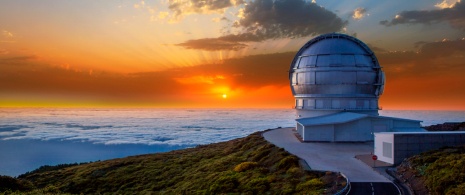
Walking among clouds and stars: Roque de los Muchachos
It is part of the National Park and, at 2,426 metres, it's the highest point on the island. Here, the landscape becomes much more colossal and rocky and you will even feel like you're walking on the clouds. On clear days, you can see the neighbouring islands of La Gomera and El Hierro and Mount Teide in the distance.If you can, stay until sunset... The silence, the colour... The experience from above is unique.
-
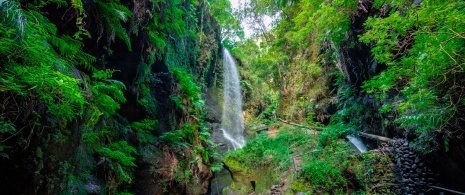
Going through tunnels in search of the springs of Marcos y Cordero
Inside of the Las Nieves – Bosque de Los Tilos Nature Reserve, one route is of particular interest. The PR PL 6 Los Sauces – Los Tilos trail. This path takes you through 13 tunnels made to route the water until it descends to the heart of the original Biosphere Reserve. The laurel forests and the waterfalls flowing from the hillside in the springs of Marcos y Cordero are simply magical. You must bear in mind that the full route is 24.5 kilometres long, and that this is a path only for experts. A simpler alternative is to take a taxi from the Los Tilos visitor centre to Casa del Monte and start a 12.5-km journey from there.
-
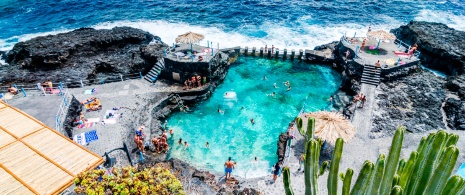
Floating in the Charco Azul
El Charco Azul, on the coast of San Andrés, is one of the best-known natural pools on the entire island. You must not miss the experience of taking a good dip in salt water if you're in the area. The contrast between the black of the volcanic rock entering the sea and the turquoise blue colour of the water will feel like you are in paradise.
-
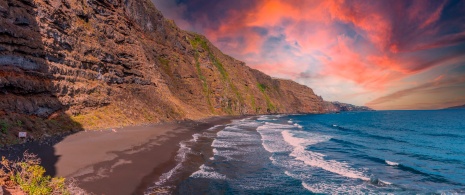
Feeling the wind between the great cliffs of Los Nogales beach
It is undoubtedly one of most beautiful beaches on the island. You have to access it on foot. In addition to its undeniable beauty, this black sand beach is known for its strong currents and waves. So, you need to be especially careful and stay close to the shore. It is also an ideal enclave for surf lovers.
-
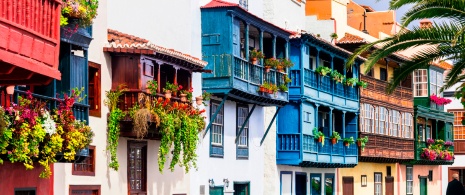
Discovering the colonial architecture of Santa Cruz de La Palma
When you visit La Palma, make sure to save time for the island's capital. Strolling through its cobbled streets will transport you to a past of transoceanic voyages and explorers, as it was an important port on the route between Europe and America. Walking through this small city is a delight. You will find colonial-style manor houses, carved wooden balconies full of flowers that look out to the sea, the Island Museum, palaces, churches, theatres... And make sure to visit the galleon Barco de la Virgen at Plaza de la Alameda, and the Castle of Santa Catalina.
-
Travelling to the Tertiary in the forests of Cubo de la Galga
This area is ideal if you are travelling as a family, because you can all do a low-difficulty circular path of about 11 kilometres, and even shorter options. It will feel like you are inside a story, as you walk through a laurel forest where magical beings seem to live. Did you know that these forests are like a relic of the almost-extinct ancient Tertiary forests?The route also links to Montaña de La Galga, with a splendid natural viewing point.
-
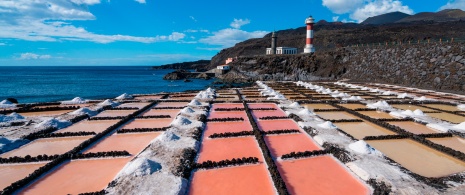
Experiencing colour in the salt flats of Fuencaliente
You will find them in the south of La Palma. Get your camera ready because this corner of La Palma stands out for its colour contrasts: the white of the salt, the black of the volcanic rock and the blue of the ocean create a living canvas. In addition, it is a resting place for migratory birds. Right next door, you will find a themed restaurant to understand the salt production process and buy products such as fleur de sel. Nearby is the beautiful lighthouse of Fuencaliente and beaches such as Las Cabras and Echentive.
-
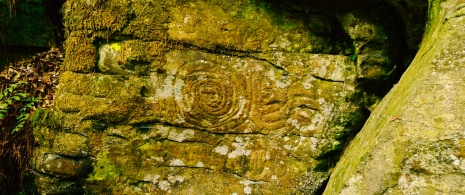
Learning about ancient settlers in the cultural park of La Zarza y La Zarcita
The town of Garafía houses this area, which is actually an interesting archaeological site. Taking a pleasant walk through the forest, you will be able to see some of the most important rock carvings on the islands. A place full of mystery and geometric and symbolic figures. Its visitor centre is being renovated to offer information about these centuries-old artistic works and the first settlers of La Palma.
-
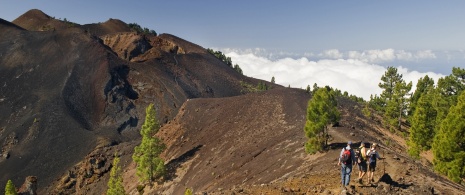
The Route of the Volcanoes
This may be the most famous hiking experience on the island. It takes you on a journey through the "lunar landscapes" of craters left by volcano eruptions. It is a demanding route of around 23 kilometres that begins at the El Pilar leisure area and ends in Los Canarios, although many visitors extend it to the Fuencaliente lighthouse. And if you can, end the route at sunset. It's simply unforgettable.
These are just a few ideas to enjoy some of the most popular places on the island. Whenever you wish to walk a path, find out about its condition beforehand on this website, since some sections may be inaccessible.La Palma is full of mysteries, secrets and pleasant surprises. Come and discover them?
Travel plans for inspiring you













